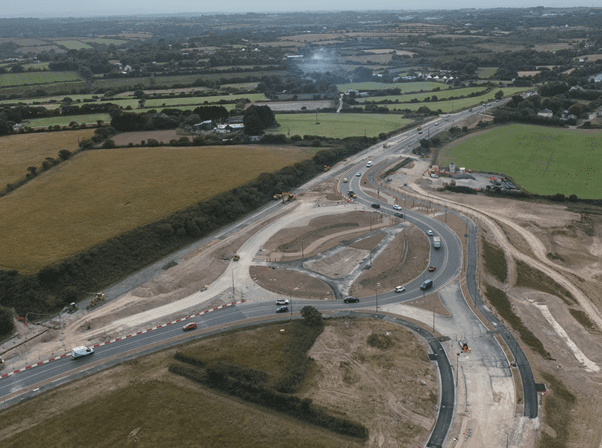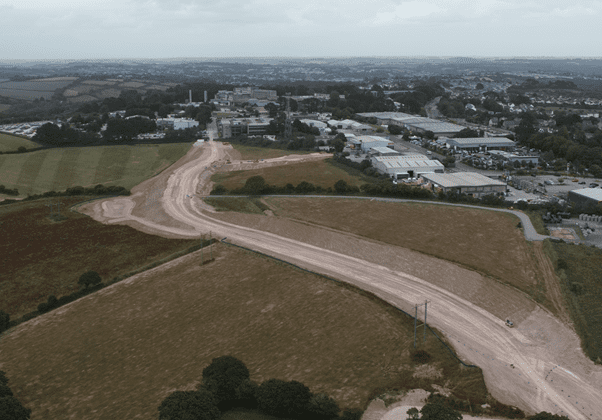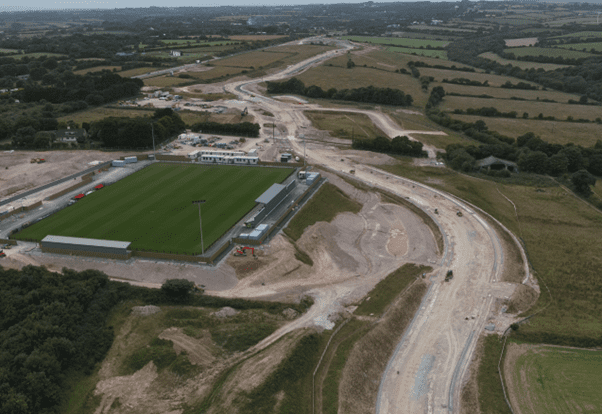You can view a short film about the project here :
Construction of the Northern Access Road (NAR), which will be re-named as Fordh Langarth when complete, is progressing well. The NAR is the major spine road which runs West to East through Langarth Garden Village and will provide access to the development plots and a route from the A390 through Langarth to the Royal Cornwall Hospital Treliske. The project is both on schedule and budget.
The new road is the first element of the Garden Village to be constructed and supports the Council’s commitment to provide key infrastructure before work begins on building the new houses. Funded by Homes England, and designed and constructed by CORMAC, the £47.5m project is being delivered in phases running West to East.
The Northern Access Road will have a 20 mph speed limit to provide a safer environment to maximise sustainable transport and create an urban feel. Between the West Langarth Junction and the Royal Cornwall Hospital, the new route will have a 3.5m wide segregated cycle lane on the north side and 2m wide footways to the north and south, creating a culture of active travel that’s quick, safe, healthy and good for the environment. The road will have five pairs of bus stops at key locations so the maximum distance to a stop will be 400m (1/4 mile). New bus services will be provided for the first home occupation.
“We said at the start of the Garden Village project that we were going to create a community rather than just providing housing at Langarth” said Olly Monk, Cornwall Council portfolio holder for housing and planning.”. This means delivering key infrastructure in the early stages of the scheme. The construction of this road opens up the whole site, providing access for the development of the village centres and community facilities as well as the new homes from day one.”
The first phase runs between the new West Langarth roundabout on the A390 to the Threemilestone park & ride. Preliminary design work for the whole scheme began in 2019 with an interim link road designed to provide access for the construction of the main road constructed in 2021. Enabling works followed including site investigation, soil sampling, ecological and environmental monitoring, archaeological investigations, site fencing, and vegetation clearance alongside the detailed design. Construction work of the new road and associated utilities and services formally began in March 2023.
Following earthworks, the drainage network has been installed to carry surface and foul water, with ducting to support the development of the geothermal district heating network. This was followed by the installation of filter drains, drainage ponds and headwalls. Then followed the installation of cycle way, foot way and highway kerbs and edging, before the sub-base and surfacing of each was carried out. Work has progressed sequentially across the site, with the new West Langarth roundabout now partially opened to allow construction of the south side of the roundabout and also complete the Saints Trails network connecting St Agnes to Threemilestone.

At the eastern end of the site, new ducting has been laid to enable the hospital to realign its fibre optic communications cables before a new gas main, water main and low voltage cables are diverted into the new footways adjacent to the helipad. Cormac have also constructed a new wall next to the helipad to provide protection from helicopter downwash.
Delivering the first phase has been a major civil engineering project. The significant challenge of constructing a road across a valley has resulted in excavating and then re-using 120,000 m3 of material across the site. Unlike many other major developments, all the excavated subsoil has been stored on site before being re-used elsewhere on the scheme to minimise material going off site.

Among the circa 100 people who are currently on site or have been involved in the construction of Fordh Langarth are a number of resident ecologists and environmental specialists who have been working to protect the impact of the works on wildlife and increase bio-diversity.
CORMAC have also worked with local schools and colleges to provide opportunities for young people to learn new skills, with apprenticeships offered in areas such as construction, building and engineering. The site has 3 apprentices and has led the way in the introduction of the Cormac T Level programme in conjunction with Truro & Penwith College. Talks to local schools about the project and sustainability have also taken place.
Formal access for the construction of Phase 2, which runs between Threemilestone park and ride and the hospital, was granted in January 2024, enabling works could then start which allowed earthworks to begin in April 2024. Work has now begun on constructing this phase of the scheme, with the earthworks completed by the end of July 2024.
Based on the current scope of work, the construction of Fordh Langarth is due to be completed by the end of 2025.
Unlike other major housing schemes, the development of the first phase of the Garden Village at West Langarth will involve creating a village centre with a range of community infrastructure, such as schools, health facilities, sport and leisure facilities, convenience stores and a business suite, as well as housing. This will include affordable homes, with homes for both social rent and shared ownership, as well as extra care facilities.

Following the completion of the Compulsory Purchase Process (CPO) in the Autumn, Langarth Garden Village will be looking to work with a small number of house builders to develop detailed plans to deliver the first 750 new homes and community infrastructure over a five-year period. Work on constructing the first houses at West Langarth is expected to begin in 2026, with the first people moving into their new homes at the beginning of 2027.
Construction of the primary school will also begin in 2026, with the school currently due to open in September 2027 when the first 200 homes have been occupied.
Ends
